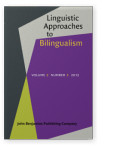Commentary
Empty myth-making
References (12)
Amaral, L., & Roeper, T.
to appear).
Multiple grammars in L1 and L2. Ms., University of Massachusetts.
Kroch, A. & Taylor, A.
(
1997)
Verb movement in old and middle English: Dialect variation and language contact. In
A. van Kemenade &
N.l Vincent (Eds.),
Parameters of morphosyntactic change (pp. 297–325). Cambridge: Cambridge University Press.

Limbach, M., & Adone, D.
(
2010)
Language acquisition of recursive possessives in English.
Boston University Conference on Child Language (BUCLD), 341, 281–290.

Navagrodsky, R., Roeper, T., & Yamakoshi, K.
(
2012)
Acquisition of Each and Every GALA Proceedings.

Pearson, B. Grace, M., & Roeper, T.
(
2010)
Quantifier spreading is not distributive.
BUCLD 35 Proceedings 2011. Somerville, MA: Cascadilla Press.

Roeper, T.
(
2000)
Universal bilingualism.
Bilingualism: Language and Cognition, 21, 169–186. Cambridge University Press.


Roeper, T.
(
2007)
The prism of grammar: How child language illuminates humanism. Cambridge, MA: MIT Press.


Roeper, T.
(
2011)
The Acquisition of Recursion: How Formalism Articulates the Child’s Path Biolinguistics, 5(1–2), 57–86.

Roeper, T., Terunuma, A., & Nakato-Mishiyata, T.
in progress).
Acquisition of recursive possessives in Japanese. Ms., University of Massachusetts, Amherst.
Schulz, P., & Roeper, T.
(
2011)
Acquisition of exhaustivity in wh-questions: A semantic dimension of SLI? Lingua, 121(3), 383–407.


Steele. C.M., & Aronson, J.
(
1995)
Stereotype threat and the intellectual test performance of African-Americans.
Journal of Personality and Social Psychology, 62(1), 26–37.

Yang, C. D.
(
2002)
Knowledge and learning in natural language. Oxford: Oxford University Press.

Cited by (2)
Cited by 2 other publications
Hager, Malin & Natascha Müller
2015.
Ultimate attainment in bilingual first language acquisition.
Lingua 164
► pp. 289 ff.

This list is based on CrossRef data as of 5 july 2024. Please note that it may not be complete. Sources presented here have been supplied by the respective publishers.
Any errors therein should be reported to them.
